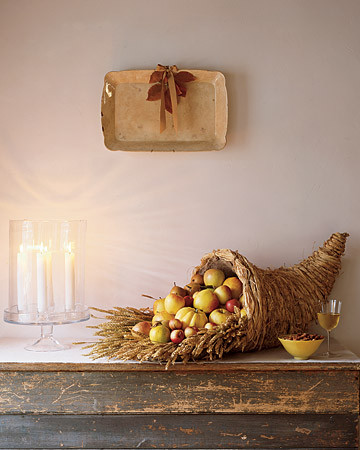

The cornucopia is an emblem of Thanksgiving and — in many homes — the bountiful centerpiece of a bustling Thanksgiving table. But the cornucopia wasn’t always synonymous with Thanksgiving. Originally, it had absolutely nothing to do with turkey or pumpkin pie.
Let’s start with the name itself. The English word “cornucopia” originates from the joining of two Latin words (“cornu”, meaning “horn,” and “copiae”, meaning “plenty”). Together, the end term became “cornucopia”, meaning “horn of plenty.”
The first recorded history of this iconic “horn of plenty” can be traced as far back as ancient Greece, roughly the fifth century B.C. Back then, the horn was actually made of a goat’s horn — a far cry from the woven, trumpet-like basket you’re used to seeing today. But like modern cornucopias, it rested at the center of the table, filled to the brim with lush vegetables, fruit, and grains.
Why a goat’s horn? The answer lies in the storied birth of Zeus, the king of the gods. According to legend, Cronus, the powerful Titan, feared that his newborn son, Zeus, would grow up to overthrow him, so Cronus was determined to destroy Zeus. To protect her newborn son, Zeus’s mother, Rhea, hatched a plan. She sent the infant Zeus out of his father’s reach, hidden away in a secret cave on Mount Ida. There, he was nurtured by his foster mother, Amalthea, until he was grown. As a sign of gratitude for her diligent mothering, Zeus presented Amalthea with a goat’s horn, imbued with the divine power to replenish itself infinitely with whatever she desired.
From there, the symbolic image of the cornucopia was one of bounty. In mythological texts, it can be seen cradled in the arms of Demeter, the goddess of grains; Fortuna, the goddess of luck; and Dionysus, the god of fertility and wine. The cornucopia became deeply rooted in the world’s history as a time-honored symbol of gratitude, good fortune, and — of course — a bountiful harvest. All of these are the core symbols of Thanksgiving.
Will you have a cornucopia on your Thanksgiving table this year?
Make Our Wicker Cornucopia for Your Thanksgiving Table
SOURCE:http://www.marthastewart.com/1093464/decorative-past-origin-story-thanksgiving-cornucopia